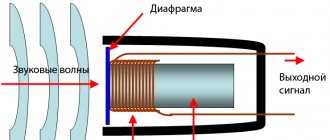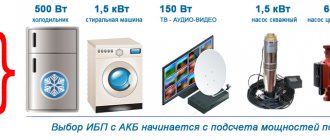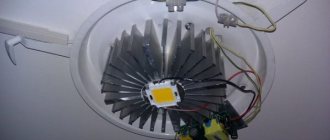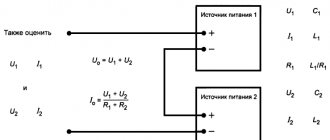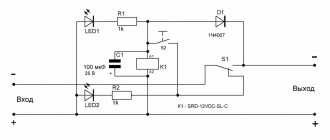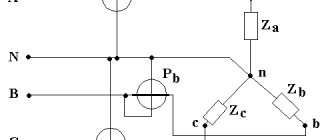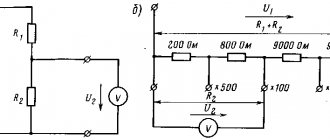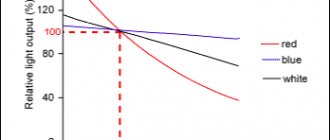Rectifier diodes
♥ The operation of semiconductor rectifier diodes is based on the property of a p–n junction to pass current in only one direction. Rectifier diodes are mainly made from the minerals germanium and silicon. A semiconductor diode is a nonlinear element. ♥ It has two branches on the current-voltage characteristic - the operation of the diode when electric current passes through the diode in the forward and reverse directions.
♥ the first branch is the operation of the diode in the forward direction
The voltage Upr varies from 0 to 1.5 volts. Three sections are distinguished on this branch: 1) with increasing voltage Upr (points 0 - 1), the current changes slightly (almost linear section). 2) non-linear section (points 1 - 2) working section, used for current rectification, as well as in devices for frequency conversion. 3) with a slight increase in voltage Upr (points 2-3), the diode current increases sharply. This phenomenon is used in current-voltage stabilization circuits.
♥ second branch - operation of the diode in the “locked” state
The reverse voltage Urev is applied to the diode. Under the influence of reverse voltage, a barrier (locking) layer appears, about 10 (-4) mm thick, which does not allow electric current to pass through. The diode reverse current Irev is very small. When the maximum permissible operating voltage is exceeded, the reverse current of the diode increases.
A reversible electrical breakdown begins, and the p-n junction begins to gradually warm up. If at this moment the reverse voltage is reduced, the reverse current will decrease to an acceptable value and breakdown will not occur. If the diode temperature exceeds the permissible value (for germanium +75 degrees, for silicon +150 degrees.
), an irreversible thermal breakdown occurs. The diode fails.
Basic electrical parameters characterizing a semiconductor diode
♥ Forward voltage and current:
Upr is a constant forward voltage caused by a constant forward current Inp. For diodes of the same power, with the same maximum forward current Ipr, through germanium and silicon diodes, the voltage drop across the p–n junction: - for germanium Upr = 0.3 - 0.7 volts, - for silicon Upr = 1, 0 – 1.5 volts. Inp - average forward current - average value of forward current over the period.
The permissible forward current decreases with increasing temperature and current repetition frequency. In powerful diodes, the forward current can reach 100 amperes or more. The electrical power dissipated on a silicon diode in the maximum forward current mode is 1.5 – 2.0 times higher than on a germanium diode. In order not to exceed the maximum permissible operating temperature of the diode, at which thermal breakdown can occur, the diode is placed on a radiator. In rectifier devices at low voltages and high currents, it is more profitable to use germanium diodes.
♥ Voltage and current in reverse direction.
Urev - the maximum permissible constant reverse voltage - this is the voltage that the diode can withstand for a long time without dangerous thermal breakdown. The maximum reverse voltage Urev, depending on the type of diode, can be the following value: - for a germanium diode, up to 100 - 400 volts; - for a silicon diode, up to 1000 - 1500 volts. Irev - The reverse current through the diode, at maximum reverse voltage, is very small and is about 1 milliampere for germanium, about 1 microampere for silicon.
From a change in thermal current: the lower the thermal current, the greater the forward voltage
Theory Read more: Frequency and pulse properties of pn junction
2. From a change in thermal current: the lower the thermal current, the greater the forward voltage.
3. From temperature changes: for germanium transitions, with increasing temperature, Upr can degenerate almost to zero.
4. From a change in the junction area: the forward voltage decreases with an increase in the junction area.
With reverse polarity of the external source (reverse biased non-conducting state of the pn junction), the polarity of the external voltage source coincides with the polarity of the contact potential difference, the potential barrier of the pn junction increases, the band gap of the junction expands, and at a certain Urev, the diffusion current through the junction almost stops. The carriers of each region are "pushed" to the edges of the semiconductor and only the minority carrier current continues to flow through the junction. The process of capturing minority carriers by an electric field and transferring them to a neighboring area is called extraction.
At low values of the reverse voltage through the pn junction, the movement of the main carriers will also be observed, forming a current opposite to the drift current:
The resulting current through the pn junction under reverse voltage
(1.4)
Equation (1.4) describes the reverse branch of the reverse-biased transition (Fig. 1.1).
When Urev is greater than 3jt, the diffusion current through the junction stops.
It was noted above that the current of the idealized junction does not depend on the applied voltage, but the real reverse current of the junction is much higher than the value of Iо; it is necessary to clearly distinguish the thermal current from the reverse current, called the thermal generation current; in silicon structures, the thermal current at room temperature is not taken into account at all, since it is 2-3 orders of magnitude less than the reverse current. For germanium junctions, the thermal current is 6 orders of magnitude greater than for silicon junctions, so this current cannot be neglected in germanium structures.
In a real junction, a rather significant dependence of the minority carrier current on the applied voltage is observed. The fact is that the processes of generation and recombination of carriers occur both in the neutral layers of the “p” and “n” regions, and in the transition itself. In the equilibrium state of the transition, the rates of generation and recombination are the same everywhere, but under the action of reverse voltage, when the band gap expands, the transition region is greatly depleted of carriers, while the recombination process slows down and the generation process becomes unbalanced. The excess of generated carriers is captured by the electric field and transferred to the neutral layers (electrons in the n-region, and holes in the p-region). These flows form the thermal generation current. Thermal generation current weakly depends on temperature and strongly depends on the magnitude of the applied reverse voltage; It is appropriate to recall the simplified formula for the dependence of the speed of an electron in an accelerating electric field on the applied voltage:
.
As the applied voltage increases, the speed of the electron increases, and the number of its collisions with atoms at lattice sites (impact ionization) increases, which leads to the appearance of new charge carriers. An increase in the number of charges leads to an increase in the current of minority carriers, the transition temperature increases, and this, in turn, leads to the breakdown of covalent bonds and the growth of carriers. The process can take on an avalanche-like character and lead to breakdown of the pn junction (Fig. 1.1). The following types of breakdowns are distinguished:
tunnel (with a transition field strength above 106 V/cm, up to point “a”);
electrical (caused by impact ionization, after point “a”), this type of breakdown is sometimes called avalanche, in which reversible processes occur in the transition and after removing the reverse voltage it restores its working properties. During an electrical breakdown, an increase in current causes almost no change in voltage, which made it possible to use this characteristic feature to stabilize the voltage;
thermal occurs as a result of strong heating of the transition (after point “b”); the processes that occur in the junction are irreversible, and the operating properties of the junction are not restored after removing the voltage (this is why the reference literature strictly limits the amount of reverse voltage at the junctions of diodes and transistors).
Rice. 1.1. Current-voltage characteristic of a real electron-hole pn junction
Conclusion. Analyzing the forward and reverse branches of the current-voltage characteristic, we come to the conclusion that the pn-junction conducts current well in the forward-biased state and very poorly in the reverse-biased state, therefore, the pn-junction has valve properties, so it can be used to convert alternating voltage to direct voltage, for example, in rectifier devices in power supplies.
1.2.1. Temperature properties of pn junction
Equation (1.1) contains temperature-dependent parameters - I0 and j t.
I0 is the thermal current, or saturation current. For an ideal junction, I0 determines the amount of reverse current, but in real junctions I0 is much less than the reverse current. The current Iо strongly depends on temperature (Fig. 1.1): even minor changes in temperature lead to a change in Iо by several orders of magnitude.
The maximum permissible increase in the reverse current of the diode determines the maximum permissible temperature for it, which is 80-100 °C for germanium diodes and 150-200 °C for silicon diodes.
The minimum permissible temperature for diodes usually ranges from 60 to -70°C.
For germanium junctions, the current I0 is six orders of magnitude greater than for silicon junctions, therefore, under the same conditions, their forward voltages are 0.35 V less and, depending on the mode, amount to 0.25-0.15 V (the turn-off voltage for germanium junctions increases temperature degenerates almost to “0”).
In Fig. 1.1, the direct branch of the characteristic, taken at 70 °C, has shifted to the left: with increasing temperature, the intrinsic conductivity of the semiconductor comes into force, the number of carriers increases, as the process of thermal generation intensifies. The reverse branch of the current-voltage characteristic (Fig. 1.1) shifts to the right, that is, with an increase in temperature to +70 °C, electrical breakdown in the junction occurs earlier than at a temperature of +20 °C. As the reverse voltage increases, a thermal generation current is added to the thermal current. In total, these two currents form a reverse current Irev through the reverse-biased junction. When the temperature changes, the new value of the reverse current can be
divide from ratio
(1.5)
where Iobr.20 oC is the value of the reverse current at a temperature not higher than 27 oC (taken from reference literature);
A is the coefficient of the material from which the semiconductor device is made (Germany = 2, Silicon = 2.5);
j t is the temperature potential, which at room temperature is 0.025 V, and at another temperature j t can be determined by the formula
(1.6)
Thus, with increasing temperature, the reverse saturation current increases approximately twofold for germanium diodes and two and a half times for silicon diodes (1.5).
Theory Read more: Frequency and pulse properties of pn junction
Information about the work "Theory"
Section: Radioelectronics Number of characters with spaces: 128780 Number of tables: 35 Number of images: 0
Similar works
Teaching sociological theory at St. Petersburg State University
25366
1
0
I also have a didactic function, taking into account the situation in Russian sociology. Directions at the fundamental level differ and are systematized in the concept of teaching sociological theory on the basis of their essential connection with various solutions to the most important philosophical, epistemological and ideological problems formulated in the history of European social thought regarding the nature...
Game theory
24554
3
7
... mixed strategies of players 1 and 2 are those sets xo, yo, respectively, that satisfy the equality E (A, x, y) = E (A, x, y) = E (A, xo, yo). The value E (A, xo,yo) is called the price of the game and is denoted by u. There is another definition of optimal mixed strategies: xo, oo are called optimal mixed strategies of players 1 and 2, respectively, if they...
Probability theory and mathematical statistics
59066
6
49
... Prove: By definition of the second mixed derivative. Let us find from the two-dimensional density the one-dimensional densities of the random variables X and Y. Since the resulting equality is true for all x, then the integrand expression is similar. In the mathematical theory of probability, it is introduced as a basic formula (1) because it is proposed that the probability density as an analytical function may not exist. But because in our …
The role of the theory of differential equations in modern mathematics and its applications
32343
0
0
... the theory of embedding of functional spaces was constructed, which are currently called Sobolev spaces. A.N. Tikhonov constructed a theory of ill-posed problems. An outstanding contribution to the modern theory of differential equations was made by Russian mathematicians N.N. Bogolyubov, A.N. Kolmogorov, I.G. Petrovsky, L.S. Pontryagin, S.L. Sobolev, A.N. Tikhonov and others. Impact on development...
The principle of operation of the diode. Volt-ampere characteristics. Breakdowns of pn transition
Hello dear readers of the site sesaga.ru. In the first part of the article, we figured out what a semiconductor is and how current arises in it. Today we will continue the topic we started and talk about the operating principle of semiconductor diodes .
Diode
is a semiconductor device with one
p-n
junction, which has two terminals (anode and cathode), and is designed for rectification, detection, stabilization, modulation, limitation and conversion of electrical signals.
According to their functional purpose, diodes are divided into rectifier, universal, pulse, microwave diodes, zener diodes, varicaps, switching, tunnel diodes, etc.
Theoretically, we know that a diode passes current in one direction and not in the other. But how and in what way he does this is not known and understood by many.
Schematically, a diode can be represented as a crystal consisting of two semiconductors (regions). One region of the crystal has conductivity p
-type, and the other with
n
-type conductivity.
There are holes in the picture
electrons that predominate in the
p
-type region are conventionally depicted as red circles, and
electrons
that predominate in
the n
-type region are shown in blue.
These two areas are the diode's electrodes anode
and
cathode
:
Anode - positive electrode
diode in which the main charge carriers are
holes
.
Cathode - negative electrode
diode in which the main charge carriers are
electrons
.
Contact contacts are applied to the outer surfaces of the areas.
metal layers to which the wire
leads
of the diode electrodes are soldered. Such a device can only be in one of two states:
1. Open
– when it conducts current well;
2. Closed
- when it conducts current poorly.
Direct connection of the diode. Direct current
If you connect a constant voltage source to the diode electrodes: to the anode terminal “ plus
" and the cathode terminal is "
minus
", then the diode will be in
the open
state and a current will flow through it, the magnitude of which will depend on the applied voltage and the properties of the diode.
With this polarity of connection, electrons from the region n
-type electrons will move towards the holes into the
p
-type region, and holes from the
p
-type region will move towards the electrons into the
n
-type region.
At the interface between the regions, called an electron-hole or pn junction , they will meet, where their mutual absorption or recombination
.
For example. Major charge carriers in the n
-type electrons, overcoming
the p-n
junction, enter the
p
-type hole region, in which they become
minority
.
Having become minority electrons, they will be absorbed by majority
carriers in the hole region -
holes
.
In the same way, holes entering the n
-type electronic region become
minority
charge carriers in this region, and will also be absorbed by
the majority
carriers -
electrons
.
Diode pin connected to negative
The pole of a constant voltage source will
give up
n
region , replenishing the decrease in electrons in this region.
And the contact connected to the positive
pole of the voltage source is capable of
accepting
the same number of electrons
from
the p the p
-type region is restored.
Thus, the conductivity pn
The junction will become
large
and the current resistance will be
small
, which means that a current will flow through the diode, called
diode current Ipr
.
Reverse connection of the diode. Reverse current
Let's change the polarity of the constant voltage source - the diode will be closed
condition.
In this case, electrons in the region n
-type will move towards
the positive
pole of the power source, moving away from
the p-n
junction, and holes in the
p
-type region will also move away from
the p-n
junction, moving towards
the negative
pole of the power source.
As a result, the boundary of the regions will seem to expand, which creates a zone depleted of holes and electrons, which will provide great
resistance to the current.
